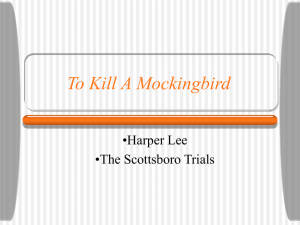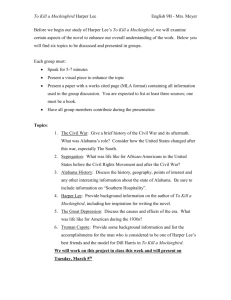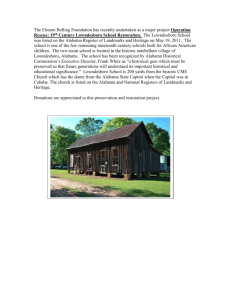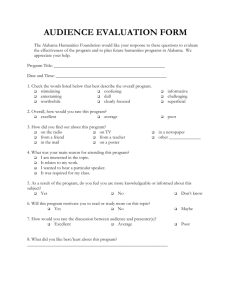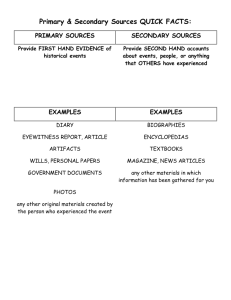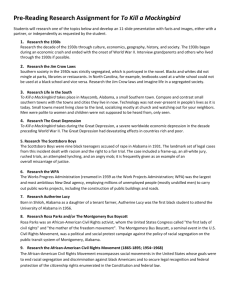Parallels Between the Scottsboro and Tom Robinson Trials
advertisement
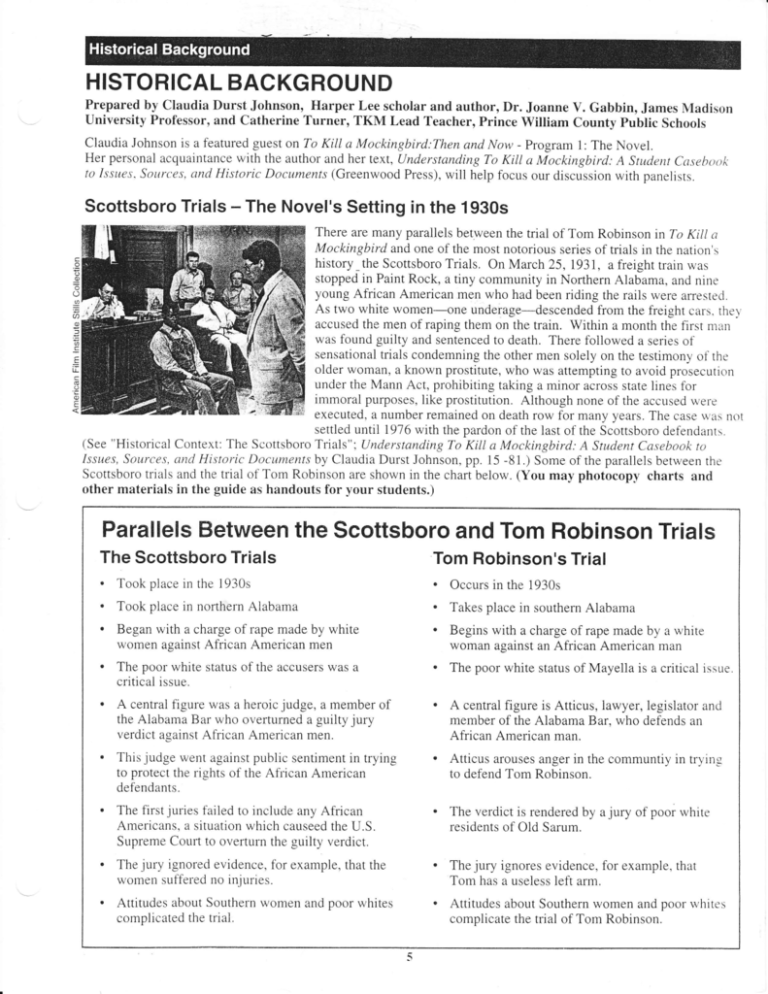
HISTORICAL BACKGROUND
Prepared by Claudia Durst Johnson, Harper Lee scholar and author, Dr. Joanne V. Gabtrin, James Madison
University Professor, and Catherine Turner, TKM Lead Teacher, Prince William County Putllic Schools
Claudia Johnson is a featured guest on To Kill a Mockingbird;Then and Now - Program 1: The Novel.
Her personal acquaintance with the author and her text, (Jnderstanding To Kilt a Mockingbircl; A Student Ca.sebo.k
to Issues. Sources, and Historic Documents (Greenwood Press), will help focus our discussion with panelists.
Scottsboro Trials
- The Novel's Setting in the 1930s
There are many parallels between the trial of Tom Robinson in To Kitt a
Mockingbird and one of the most notorious series of trials in the nation's
c
history_the Scottsboro Trials. On March 25,1937, a freight train was
.o
o
stopped in Paint Rock, a tiny community in Northern Alabama, and nine
b
O
young African American men who had been riding the rails were arested.
I
As two white women-one underage-descended from the freight cars, rhey
u)
o
accused the men of raping them on the train. Within a month the first man
f,
F
was found guilty and sentenced to death. There followed a series of
c
sensational triais condemning the other men solely on the testimony ol the
IiI
older woman, a known prostitute, who was attempting to avoid prosecution
under the Mann Act, prohibiting taking a minor across state lines for
immoral purposes, like prostitution. Although none of the accused were
executed, a number remained on death row for many years. The case was not
settled until 1976 with the pardon of the last of the Scottsboro defendants.
(See "Historical Context: The Scottsboro Trials"; Understandirug To Kill a Mockingbird; A Studenr Casebook to
Issues, Sottrce.s, and Historic Docuntents by Claudia Durst Johnson, pp. l5 -81.) Some of the parallels between the
Scottsboro trials and the trial o1 Tom Robinson are shown in the chart below. (You may photocopy charts and
other materials in the guide as handouts for your students.)
Parallels Between the Scottsboro and Tom Robinson Trials
The Scottsboro Trials
Tom Robinson's Trial
.
.
.
Took place in northern Alabama
.
.
.
Takes place in southern Alabama
.
The poor white status of the accusers was a
.
The poor white status of Mayella is a critical issue.
Took place in the 1930s
Began with a charge of rape made by white
women against African American men
Occurs in the 1930s
Begins with a charge of rape made by a white
woman against an African American man
critical issue.
.
A central figure was a heroic judge,
a member
.
of
the Alabama Bar who overturned a guilty jury
verdict against African American men.
.
This judge went against public sentiment in trying
to protect the rights of the African American
defendants.
.
.
The first juries failed to include any African
Americans. a situation which causeed the U.S.
Supreme Court to overturn the guilty verdict.
.
.
The jury ignored evidence, tor example, that the
woff)en suffered no injuries.
.
.
.
Attitudes about Southern women and poor whites
complicated the trral.
5
A central figure is Atticus, lawyer, legislator and
member of the Alabama Bar, who defends an
African American man.
Atticus arouses anger in the communtiy in tr1 inr
to defend Tom Robinson.
The verdict is rendered by
residents of Old Sarum.
a
jury of poor white
jury ignores evidence, for example, that
Tom has a useless left arm.
The
Attitudes about Southern women and poor whites
complicate the trial of Tom Robinson.
The Author and the Book
Nelle Harper Lee, the author of To Kill a Mockingbird,had many childhood experiences which are similar to
those ofher narrator, Scout Finch.
Harper Lee's Childhood:
.
.
Grew up in 1930s
Father
-
-
Amasa Lee
Grew up in 1930s
rural southem Alabama town
-
attorney who served in
Father
rural southern Alabama town
- Atticus Finch -
attorney who served in
state legislature in Alabama
state legislature in Alabama
.
-
Older brother and young neighbor (Truman Capote)
Older brother and young neighbor (Dill)
are playmates.
are playmates.
'
Harper Lee - an avid reader
Scout reads before she enters school; reads
Mobile Register paper in first grade.
.
Six years old when Scottsboro trials were
meticulously covered in state and local newspapers
'
Visit "Preparation Activities for the Broadcast" for
information on "The Author and the Book."
Six years old when the trial of Tom Robinson
takes place
expanded
The Civil Rights Era - Setting the Historical Context for the Novel and the Film
student newspaper, graduated from novel shot to the top of the New York
Lee wrote the novel during the
Times Best Seller list, as it began to
the university and entered iaw
beginning of the Civil Rights era
(from about 1955 to 1958). Alabama school, leaving one semester short of make its remarkable impact on a
receiving a law degree. Lee's book divided nation. A year after its
was very much in the news at this
publication Lee worked as a
was published in 1960-a time of
bus
time with the Montgomery
as
consultant on the film adaptation of
and
racial
strife
events
tumultuous
rise
to
King's
boycott, Martin Luther
the novel and the screenplay written
Rights
in
the
Civil
the
struggle
Lucy's
leadership, and Autherine
grew
violent
and
spread
by Horton Foote. The film was
movement
of
attempt to enter the University
into
released in 1962 and went on to
nation,
and
across
the
into
cities
Harper
Alabama graduate school.
receive
five Academy Award
on
TV
consciousness
the
American
campus
on
Lee, who was well known
winning three.
news.
The
nominations,
nightly
and
the
screens
as editor of the politcially satirical
Charles Moore
PublicatiodRelease of To Kill a Mockingbird in the Civil Rights Era: A Chronology
1954
United States Supreme Court rules in Brown vs. Board of Education of Topeka, Kansas, that racial
segregation in the public schools is inherently unequal and, therefore, iilegal.
1955
1955
1955
1956
1956
Rosa Parks is arrested for refusing to give up her seat on a Montgomery city bus.
Boycott of Montgomery County city buses begins officialiy.
Emmett
a young African American man, is murdered while visiting the South.
Autherine Lucy receives a letter granting permission to enroll for classes at the U. of Alabama, Tuscaloosa.
Home of Martin Luther King, Jr. is bombed in Montgomery. King is a leader in the boycott and designated
s
1956
1956
Till,
pokesperson.
Motions are filed in U.S. District Court cailing for an end to bus segregation.
Violence erupts on the campus of the U. of Alabama and in the streets of Tuscaioosa; cor-rtinuing fbr three days.
(TV evening news and Movietone newsreels showing "Week In Review" newsclips in between feature films
in movie theaters docurnented these events.)
1956
Autherine Lucy is forced to flee U. of Alabama campus; the university's Board of Trustees bars her tiom campus.
(TV/ Movietone)
1956
1956
Warrants are issued for arrest of 115 ieaders of the Montgomery bus boycott.
1956
1956
L957
1960
.
1961
U.S. Supreme Court decides in favor of Montgomery bus boycotters, by ruling bus segregation illegal.
Autherine Lucy ordered by the courts to be re-admitted to U. of Alabama, only to be expelled by Board of Trustees.
(TV / Movietone)
African Americans first board buses in Montgomery, according to a first-come, first-served basis. (TV,/N4ovietone )
Federal troops sent to Little Rock, Arkansas, to enforce court-ordered desegregation of schools. (TVMovietonel
Publication of To Kill A Mockingbird in the Fall (Shoots to top of NY Times Best Seller list) ...In Greensboro, N.C..
attempt to integrate lunch counters is thwarted (TV/Movietone).
Charlayne Hunter enters the U. of Georgia through lines of jeering
white protesters (TV/Movietone)
l96L
Freedom Riders begin arriving in the deep South to test
desegregation. Violence necessitates the deployment of
f'ederal troops. (Major TV news event/Movietone )
196l
Violence erupts at U. of Mississippi over integration (fealured
on TV networks, in newspapers and magazines,Movietone).
1962
To Kill A Mockingblrd, is released, the screen adaptation by
Horton Foote receives 5 Academy Award nominations.
1963
Dogs and power hoses are directed at peaceful demonstrators
in Bilmingham, Alabama; America watched on TV news.
1963
1963
1964
1965
Three Civil Rights workers are found rnurdered in Mississippi.
Massive Civil Rights March is held in Washington, D.C.
The Civil Righls Act is passed.
March for Voting Rights is held in Selma, Alabama.
American Film lnstitute Stills Collection
Historical Background Pre-Teleconference Discussion Questions
. Compare the kinds and levei and frequency of violence in the society of Maycomb in the 1930s and violence in
1
American communities today.
2.
What changes have taken place between the time of the novel and today? Consider, for example, farnily relationships
then and now; use of language then and now; expectations of the behavior of linle girls then and now: the use of gLrns
to resolve conflict then and now;justice in the courts, then and now, (e.g., the O. J. Simpson tnals;.
3..
Conduct research on how the book and the film were received by the pubiic and by book reviewers. See. for
example, issues of the Neu' York Times. Time magazine, and other sources begrnning around autumn of 1960.
What kind of impact does it appear the book had on the public; on society? Document and share with class.
EO, IilHO WAE
drrl GROrf flNY-lryf,rr
Jim Crow wasn't r real penson. A white entertaincr named Thomas Rice is said to
have met a bleckhandyman naned Jim crow. Rice mede up r song euout.lin
crow who sang, danced, end never caused rnyone any troubie. Rici who uscd
*blacldace' makeup' $lng the eong in a New
York theatre in 1932; it was a hit right
aw8y. The name Jim Crow stuck end soon referred to the policy of segregation
wbere blacks' like Jim Crow, actcd as_if nothing bothered themrin spi-e olthe acts
of prejudice and discriminstion that.they faced cveq/ day. Segregation in the Nofth
was established through a tredition; in thc South, it becsme a ierils of regulations
actually passed by southern lawmakers. r.et's see how.that happened.
In t8t1' the state of Tennessee was the first of all the Southerri-states that passed a
bill to segregate railroad cars. This bill set the stage for other such laws. io tggg,
the Georgia General Assembly passed laws which segregated tireatres, convict
prison campsr water fountains, restrooms, restaurants, park bencbes, and other
public facilities. It was common to see signs in much of the Souin, which stated,
"WHITES ONLY."
Then, in 1896, something very significant happened: a Supreme Court case cslled
PLESSY v. FERGUSON. Eomer Plessy, a black man, had sued a railroad because
he believed that according to the Fourteenth Amendment o{the Constitution,
segregation was illegal. All of the courts thet heard his case disagreed with him, and
in 1E96, he appcaled to the Supreme
9o!rt The Supremc Cout-*I"a tnu if sepiarae
but equalfacilities were providedfor blaclcs, that segiegation v'as legal. pretfo soon
spons' hospitals, orphanages, funeral homcs, and cemeteries werJsubject to the
specifications requiring whites end blacla to be seperrted. Segregation had been
legalized. The Jim crow laws were n6t repealed untit the 1960s.

